

Dunning's History Now - August 2011
Saturday 27th August 2011 - What a Spectacular Day!
The 500th Anniversary of the elevation of Dunning
to the status of Burgh of Barony and Regality.
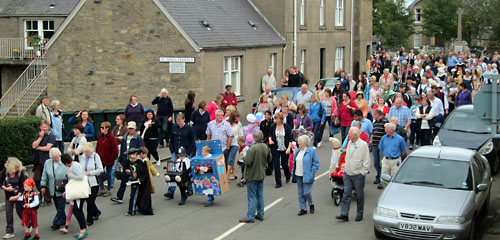

Things started with a procession from the memorial green, with many children and adults in fancy dress. As they entered the merkat gait they caught first sight of the street of over 40 trading stalls and other attractions and games, leading to the mercat steid where Lord Rollo formally opened the event.
Close by, the golf, tennis and bowling clubs had also arranged entertainments which proved extremely popular, and not far away Historic Scotland had laid on a special exhibition at St Serf's church, and the Kirkstyle Pub offered a special Dunning Brew of ale.
Among a huge variety of items for sale ranging from soft fruit to arts and crafts, were a specially commissioned postcard set and some beautiful high quality commemorative souvenir T-shirts. There were prize lambs on show, a spectacular Jacobite re-enactment by "Alba", a vintage fire engine, barbecue and ice-cream, tea and cakes....the list just goes on.
The Parade was started by the Town Crier. 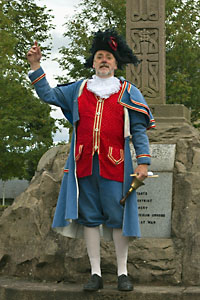
And led into the Market Street by the |
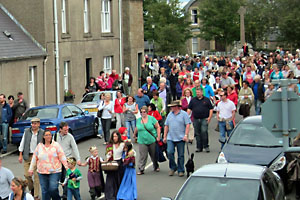 |
 | |
 |
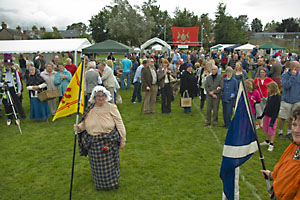 |
 |
 |
 |
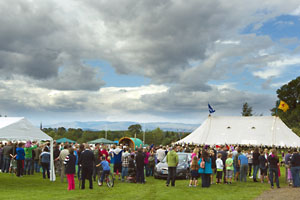 |
The annual duck race, normally held on Flower Show day, had been postponed due to bad weather,and took place soon after the mercat closed. Then it was the turn of the pubs and bowling club, who between them provided entertainment well into the night. What a day! But the point was well made that it was the granting of this status that allowed Dunning to become the active, prosperous and successful village it is today. Well worth celebrating! | |
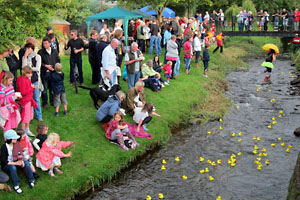 |
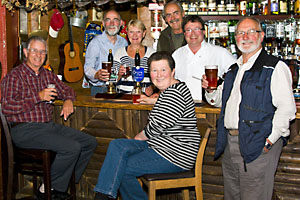 |
On Sunday our Songs of Praise in the ancient Rollo Park marquee incorporated a hymn from each century from 1511 to 2011. . 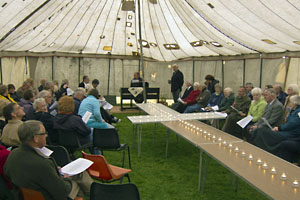 |
|
The article below will explain the significance of this major event in Dunning's long history.
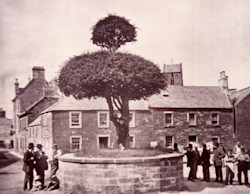 The Barony is older than the Thorn Tree
The Barony is older than the Thorn Tree |
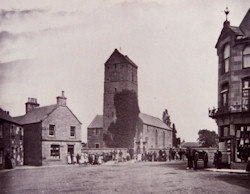 St Serf's Church existed prior to the Barony, but not in this form.
St Serf's Church existed prior to the Barony, but not in this form. |
DUNNING 1511 – by Peter Duncan
On 26th August 1511 Dunning was erected into a Burgh of Barony. However, to explain this event it is necessary to go back a few centuries.
It was not until the reign of Malcolm Canmore (1050-93) that Scotland attained some stability, allowing settlements or burghs to be established. Prior to his reign Scotland was not as we know it today. Angles occupied the country up to the river Forth, Picts and Scots were north of the Forth and Vikings occupied Caithness, Sutherland and the islands. His son David 1st (1124-53) who was Earl of Huntingdon through his marriage to a Norman/English heiress as well as King of Scotland, learned at first hand how Henry 1st governed through his nobles by the feudal system. David encouraged Norman knights into Scotland. Thus we find that Normans with names which are often taken as Scottish, such as Bruce, Sinclair, Fraser, Barclay, Crighton, Grant, Maxwell, Beaton, Lindsay, Rollo etc settled in Scotland. This led to the building of Castles, Monasteries and Abbeys, and settlements or burghs began to appear. Soon after, we had the establishment of Royal Burghs. These were created by Royal assent and gave the burghs the following rights:
- To be protected by a wall or palisade with gates.
- To elect their own council and magistrates and make laws for local maters.
- Exclusive rights to trade. A monopoly of all commerce within a defined surrounding area known as “liberty”. Items sold in this area must have been made by craftsmen in the burgh and sold there by a merchant, or taxed if they came from elsewhere.
- To hold annual fairs or weekly markets (numbers of fairs were specified by the king).
- To trade overseas or sell foreign imports. Outsiders could not sell direct but had to wholesale through burgh merchants.
In return for the benefits of Royal Burgh status the King received in return:
- Loyalty of the townspeople and local nobility (Royal Burgh status could be revoked).
- Money. The Royal Burghs were expected to pay 1/6 th of the needs of the royal exchequer. The amount from each place was fixed by the convention of Royal Burghs, an independent body of representatives from the most important burghs. This was calculated according to each burgh’s income from trade, tolls and customs. In 1612 the split up was Edinburgh 30%, Dundee 10%, Aberdeen 8%, Perth 4%, Glasgow 4%. In 1690 the percentages were Edinburgh 30, Glasgow 12, Aberdeen 7, Dundee 6 and Perth 4.
Royal Burghs were also expected to contribute to exceptional cost such as military campaigns.
This was the state of affairs until the spread of Burghs of Barony, more correctly Burghs of Barony and Regality. These were a lesser category of burgh established by a charter from the local feudal lord, one of the King’s “tenants-in-chief” rather than the King himself. These burghs were allowed to have:
- Resident craftsmen, weekly markets and market tolls.
- To hold fairs
They had no right to foreign trade as this was restricted to Royal Burghs. The revenue from trade and tolls went to the local landowner.
So, on 26 th August 1511, William Rollo established Dunning as a Burgh of Barony.
The other Burghs of Barony in this area were Abernethy, Crieff and Blackford, only Abernethy being older than Dunning. (Of course, Perth and Auchterarder were already Royal Burghs.) The King naturally had the power to revoke these establishments.
 The mural on the old Telephone Exchange building
The mural on the old Telephone Exchange building